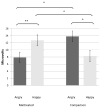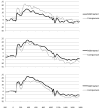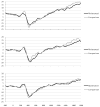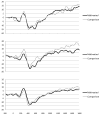Affective facial expression processing in 15-month-old infants who have experienced maltreatment: an event-related potential study
- PMID: 23644415
- PMCID: PMC4162637
- DOI: 10.1177/1077559513487944
Affective facial expression processing in 15-month-old infants who have experienced maltreatment: an event-related potential study
Abstract
This study examined the neural correlates of facial affect processing in 15 month-old maltreated and nonmaltreated infants. Event-related potentials (ERPs) were elicited while infants passively viewed standardized pictures of female models posing angry, happy, and neutral facial expressions. Differences between maltreated (N = 25) and nonmaltreated (N = 20) infants were observed on three ERP components: P1, P260, and Nc. The results for the P260 waveform were consistent with previous ERP findings in older maltreated children, showing a hyperresponsivity to angry facial affect relative to happy in maltreated infants. However, the findings for the P1 and Nc indicated a hyperresponsivity to relative affective novelty, whereby the maltreated infants had greater amplitude in response to happy facial affect, whereas nonmaltreated infants had greater responsivity to angry faces. The results provided further support for the hypothesis that the experience of maltreatment and the predominantly negative emotional tone in maltreating families alters the functioning of neural systems associated with the processing of facial emotion. In particular, the findings suggested that at this early stage in the development of facial affect recognition, novelty of facial emotion is especially salient. These results exemplify the importance of early preventive interventions focused on emotion for children who have experienced maltreatment early in life.
Keywords: child maltreatment; emotion; event-related potentials; face processing.
Figures






Similar articles
-
Affective facial expression processing in young children who have experienced maltreatment during the first year of life: an event-related potential study.Dev Psychopathol. 2011 May;23(2):373-95. doi: 10.1017/S0954579411000125. Dev Psychopathol. 2011. PMID: 23786684
-
An event-related potential study of the processing of affective facial expressions in young children who experienced maltreatment during the first year of life.Dev Psychopathol. 2005 Summer;17(3):641-77. doi: 10.1017/S0954579405050315. Dev Psychopathol. 2005. PMID: 16262986
-
P3b reflects maltreated children's reactions to facial displays of emotion.Psychophysiology. 2001 Mar;38(2):267-74. Psychophysiology. 2001. PMID: 11347872 Clinical Trial.
-
Early ERP components to emotional facial expressions in young adult victims of childhood maltreatment.Psychiatry Res. 2019 May;275:120-128. doi: 10.1016/j.psychres.2019.03.024. Epub 2019 Mar 15. Psychiatry Res. 2019. PMID: 30901670
-
Emotion in motion: Facial dynamics affect infants' neural processing of emotions.Dev Psychobiol. 2019 Sep;61(6):843-858. doi: 10.1002/dev.21860. Epub 2019 Apr 29. Dev Psychobiol. 2019. PMID: 31032893
Cited by
-
Rapid Infant Prefrontal Cortex Development and Sensitivity to Early Environmental Experience.Dev Rev. 2018 Jun;48:113-144. doi: 10.1016/j.dr.2018.02.003. Epub 2018 Mar 11. Dev Rev. 2018. PMID: 30270962 Free PMC article.
-
Between faces: childhood adversity is associated with reduced threat-safety discrimination during facial expression processing in adolescence.BMC Med. 2024 Sep 11;22(1):382. doi: 10.1186/s12916-024-03610-w. BMC Med. 2024. PMID: 39256825 Free PMC article.
-
Facial emotion processing and recognition among maltreated children: a systematic literature review.Front Psychol. 2014 Dec 17;5:1460. doi: 10.3389/fpsyg.2014.01460. eCollection 2014. Front Psychol. 2014. PMID: 25566138 Free PMC article. Review.
-
Leveraging translational neuroscience to inform early intervention and addiction prevention for children exposed to early life stress.Neurobiol Stress. 2018 Oct 26;9:231-240. doi: 10.1016/j.ynstr.2018.10.004. eCollection 2018 Nov. Neurobiol Stress. 2018. PMID: 30450387 Free PMC article. Review.
-
Early Adverse Experiences and the Developing Brain.Neuropsychopharmacology. 2016 Jan;41(1):177-96. doi: 10.1038/npp.2015.252. Epub 2015 Sep 3. Neuropsychopharmacology. 2016. PMID: 26334107 Free PMC article. Review.
References
-
- Azar ST. Parenting and child maltreatment. In: Bornstein MH, editor. Handbook of parenting: Vol. 4: Social conditions and applied parenting. 2. Mahwah, NJ US: Lawrence Erlbaum Associates Publishers; 2002. pp. 361–388.
-
- Barnett D, Manly JT, Cicchetti D. Defining child maltreatment: The interface between policy and research. In: Cicchetti D, Toth SL, editors. Child abuse, child development, and social policy. Norwood, NJ: Ablex; 1993. pp. 7–73.
-
- Batty M, Taylor MJ. The development of emotional face processing during childhood. Developmental Science. 2006;9:207–220. - PubMed
-
- Bayley N. The Bayley scales of infant development. 2. San Antonio, TX: The Psychological Corporation; 1993.
Publication types
MeSH terms
Grants and funding
LinkOut - more resources
Full Text Sources
Other Literature Sources

